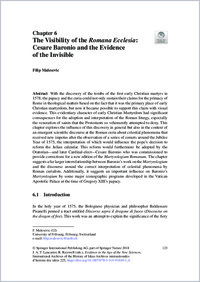The Visibility of the `Romana Ecclesia'. Cesare Baronio and the Evidence of the Invisible
- Malesevic, Filip Université de Fribourg
-
2018
Published in:
- Evidence in the Age of the New Sciences / Raiswell, Richard. - 2018, p. 123-150
English
With the discovery of the tombs of the first early Christian martyrs in 1578, the papacy and the curia could not only sustain their claims for the primacy of Rome in theological matters based on the fact that it was the primary place of early Christian martyrdom, but now it became possible to support this claim with visual evidence. This evidentiary character of early Christian Martyrdom had significant consequences for the adoption and interpretation of the Roman liturgy, especially the veneration of saints that the Protestants so vehemently attempted to deny. This chapter explores the influence of this discovery in general but also in the context of an emergent scientific discourse at the Roman curia about celestial phenomena that received new impetus after the observation of a series of comets around the Jubilee Year of 1575, the interpretation of which would influence the pope’s decision to reform the Julian calendar. This reform would furthermore be adopted by the Oratorian—and later Cardinal-elect—Cesare Baronio who was commissioned to provide corrections for a new edition of the Martyrologium Romanum. The chapter suggests a far larger interrelationship between Baronio’s work on the Martyrologium and the discourse around the correct interpretation of celestial phenomena by Roman curialists. Additionally, it suggests an important influence on Baronio’s Martyrologium by some major iconographic programs developed in the Vatican Apostolic Palace at the time of Gregory XIII’s papacy.
- Faculty
- Faculté des lettres et des sciences humaines
- Department
- Département d'histoire
- Language
-
- English
- Classification
- History
- License
-
License undefined
- Identifiers
-
- RERO DOC 324226
- DOI 10.1007/978-3-319-91869-3_6
- Persistent URL
- https://folia.unifr.ch/unifr/documents/307517
Statistics
Document views: 87
File downloads:
- Texte intégral: 393
